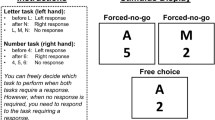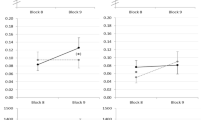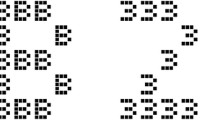Abstract
A part of action preparation is deciding what the relevant task is. This task-decision process is conceptually separate from response selection. To show this, the authors manipulated task conflict in a spatial task-switching paradigm, using conflict stimuli that appeared during trials with univalent targets (affording 1 task). The conflict stimuli afforded task identity because they were used as task cues with bivalent targets (affording 2 tasks) that were intermixed with the univalent targets. Thus, for univalent targets, irrelevant stimuli either caused low task conflict or high task conflict. In three experiments, the authors found poorer performance in high task conflict trials than in low task conflict trials. Task conflict was introduced during target appearance (Experiment 1) or task preparation (Experiments 2 and 3). In the latter case, the task conflict effect decreased with increasing task preparation time showing that task preparation involves task decision.


Similar content being viewed by others
References
Allport, A., Styles, E. A., & Hsieh, S. (1994). Shifting intentional set: Exploring the dynamic control of tasks. Attention and Performance, 15, 421–452.
Altmann, E. M., & Gray, W. D. (2008). An integrated model of cognitive control in task switching. Psychological Review, 115, 602–639.
Biederman, I. (1972). Human performance in contingent information processing tasks. Journal of Experimental Psychology, 93, 219–238.
Brass, M., & von Cramon, D. (2004). Selection for cognitive control: A functional magnetic resonance imaging study on the selection of task-relevant information. Journal of Neuroscience, 24, 8847.
Dreisbach, G., Haider, H., & Kluwe, R. H. (2002). Preparatory processes in the task-switching paradigm: Evidence from the use of probability cues. Journal of Experimental Psychology. Learning, Memory, and Cognition, 28, 468–483.
Gade, M., & Koch, I. (2007). Cue–task associations in task switching. The Quarterly Journal of Experimental Psychology, 60, 762–769.
Gilbert, S., & Shallice, T. (2002). Task switching: A PDP model. Cognitive Psychology, 44, 297–337.
Goldfarb, L., & Henik, A. (2007). Evidence for task conflict in the Stroop effect. Journal of Experimental Psychology: Human Perception and Performance, 33, 1170–1176.
Gotler, A., Meiran, N., & Tzelgov, J. (2003). Nonintentional task set activation: Evidence from implicit task sequence learning. Psychonomic Bulletin & Review, 10, 890–896.
Haggard, P. (2008). Human volition: towards a neuroscience of will. Nature Reviews Neuroscience, 9, 934–946.
Heuer, H., Schmidtke, V., & Kleinsorge, T. (2001). Implicit learning of sequences of tasks. Journal of Experimental Psychology. Learning, Memory, and Cognition, 27, 967–983.
Jersild, A. T. (1927). Mental set and shift. Archives of Psychology, Whole No. 89.
Koch, I. (2001). Automatic and intentional activation of task-sets. Journal of Experimental Psychology. Learning, Memory, and Cognition, 27, 1474–1486.
Kornblum, S., Hasbroucq, T., & Osman, A. (1990). Dimensional overlap: Cognitive basis for stimulus–response compatibility––A model and taxonomy. Psychological Review, 97, 253–270.
MacLeod, C. M. (1991). Half a century of research on the Stroop effect: An integrative review. Psychological Bulletin, 109, 163–203.
Mayr, U., & Keele, S. W. (2000). Changing internal constraints on action: The role of backward inhibition. Journal of Experimental Psychology: General, 129, 4–26.
Meiran, N. (1996). Reconfiguration of processing mode prior to task performance. Journal of Experimental Psychology. Learning, Memory, and Cognition, 22, 1423–1442.
Meiran, N. (2000). Reconfiguration of stimulus task-sets and response task-sets during task switching. In S. Monsell & J. Driver (Eds.), Control of cognitive processes: Attention and performance XVIII (pp. 377–400). Cambridge: MIT Press.
Meiran, N. (2008). The dual implication of dual affordance: Stimulus-task binding and attentional focus changing during task preparation. Experimental Psychology, 55, 251–259.
Meiran, N. (2010). Task switching: Mechanisms underlying rigid vs. flexible self control. In R. Hassin, K. Ochsner, & Y. Trope (Eds.) Social cognition and social neuroscience. NY: Oxford University Press (in press).
Meiran, N., & Daichman, A. (2005). Advance task preparation reduces task error rate in the cuing task-switching paradigm. Memory & Cognition, 33, 1272–1288.
Meiran, N., & Kessler, Y. (2008). The task rule congruency effect in task switching reflects activated long term memory. Journal of Experimental Psychology: Human Perception and Performance, 34, 137–157.
Meiran, N., Kessler, Y., & Adi-Japha, E. (2008). Control by action representation and input selection (CARIS): A theoretical framework for task switching. Psychological Research, 72, 473–500.
Monsell, S. (2003). Task switching. Trends in Cognitive Sciences, 7, 134–140.
Monsell, S., Taylor, T., & Murphy, K. (2001). Naming the color of a word: Is it responses or task sets that compete? Memory & Cognition, 29, 137–151.
Norman, D. A., & Shallice, T. (1986). Attention to action: Willed and automatic control of behavior. In R. Davidson, G. Schwartz & D. Shapiro (Eds.), Consciousness and self regulation: Advances in research and theory (Vol. 4, pp. 1–18). New York: Plenum.
Rubin, O., & Koch, I. (2006). Exogenous influences on task set activation in task switching. The Quarterly Journal of Experimental Psychology, 59, 1033–1046.
Rubin, O., & Meiran, N. (2005). On the origins of the task mixing cost in the cuing task-switching paradigm. Journal of Experimental Psychology. Learning, Memory, and Cognition, 31, 1477–1491.
Rubinstein, J. S., Meyer, D. E., & Evans, J. E. (2001). Executive control of cognitive processes in task switching. Journal of Experimental Psychology: Human Perception and Performance, 27, 763–797.
Ruthruff, E., Remington, R. W., & Johnston, J. C. (2001). Switching between simple cognitive tasks: The interaction of top-down and bottom-up factors. Journal of Experimental Psychology: Human Perception and Performance, 27, 1404–1419.
Schneider, D. W., & Logan, G. D. (2005). Modeling task switching without switching tasks: A short-term priming account of explicitly cued performance. Journal of Experimental Psychology: General, 134, 343–367.
Schuch, S., & Koch, I. (2003). The role of response selection for inhibition of task sets in task shifting. Journal of Experimental Psychology: Human Perception and Performance, 29, 92–105.
Sohn, M. H., & Anderson, J. R. (2001). Task preparation and task repetition: Two-component model of task switching. Journal of Experimental Psychology: General, 130, 764–778.
Sohn, M. H., & Carlson, R. (2000). Effects of repetition and foreknowledge in task-set reconfiguration. Journal of Experimental Psychology. Learning, Memory, and Cognition, 26, 1445–1460.
Spector, A., & Biederman, I. (1976). Mental set and mental shift revisited. American Journal of Psychology, 89, 669–679.
Steinhauser, M., & Hübner, R. (2009). Distinguishing response conflict and task conflict in the Stroop task: Evidence from ex-Gaussian distribution analysis. Journal of Experimental Psychology: Human Perception and Performance, 35, 1398–1412.
Sudevan, P., & Taylor, D. A. (1987). The cuing and priming of cognitive operations. Journal of Experimental Psychology: Human Perception and Performance, 13, 89–103.
Vallacher, R. R., & Wegner, D. M. (1987). What do people think they’re doing? Action identification and human behavior. Psychological Review, 94, 3–15.
Acknowledgments
We thank the reviewers, the action editor and Iring Koch for valuable comments on this article.
Author information
Authors and Affiliations
Corresponding author
Rights and permissions
About this article
Cite this article
Braverman, A., Meiran, N. Task conflict effect in task switching. Psychological Research 74, 568–578 (2010). https://doi.org/10.1007/s00426-010-0279-2
Received:
Accepted:
Published:
Issue Date:
DOI: https://doi.org/10.1007/s00426-010-0279-2




